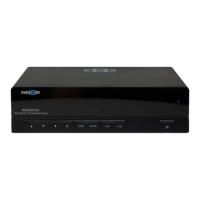
Do you have a question about the Mede8er MED800X and is the answer not in the manual?
| Model | MED800X |
|---|---|
| Category | Media Player |
| Chipset | Realtek RTD1185 |
| USB | 2 x USB 2.0 |
| Card Reader | SD/SDHC |
| Output Resolution | Up to 1080p |
| Image Formats | JPEG, BMP, PNG, GIF |
| Weight | 1.2 kg |
| RAM | 256MB |
| Video Output | HDMI, Component, Composite |
| Audio Output | HDMI, Optical, Stereo RCA |
| Network | 10/100 Ethernet |
| Supported Video Formats | MKV, AVI, MP4, MOV, ISO |
| Supported Video Codecs | MPEG-1, MPEG-2, MPEG-4, H.264 |
| Supported Audio Formats | MP3, WMA, AAC, FLAC, WAV, OGG |
| Subtitle Support | SRT, SUB, SSA, ASS |
| Operating System | Linux-based |
Connect TV using RCA analog audio and composite video outputs.
Connect via HDMI, RJ45, Coax Digital, or Toslink for digital audio.
Cycle through video output options (Composite, Component, HDMI) to get a picture.
Adjust display settings for accurate video playback and image zoom.
Configure audio output for stereo, digital, or HDMI with specific formats.
Recommended settings for HDMI audio passthrough and multi-channel formats.
Settings for optical and coaxial digital audio output and downmixing.
Automatic IP address assignment for network connection.
Manual static IP address configuration for network.
Creating shortcuts to secure network shares with user credentials.
Accessing network shares without username or password via Media Library.
Connecting the device using a compatible USB Wi-Fi dongle.
Installing a factory-fitted PCIe Wi-Fi kit and antenna.
Selecting a Wi-Fi network (SSID) from the available list.
Entering the Wi-Fi router's security key for protected networks.
Setting up DHCP or static IP addresses for wireless connection.
Verifying the wireless network connection status and details.
Updating firmware via the setup menu using a USB flash drive.
Resetting the device to default settings in case of update failure.
Browsing shared files on the network via Samba.
Enabling password protection for Samba network shares.
Creating and managing shortcuts for quick access to content.
Browsing and managing media files from various sources.
Streaming online YouTube videos directly to the TV.
Accessing online content like web browser, social media, and radio.
Personalizing device settings and options.
Structuring movie folders with specific files for XML search.
Building the database file for XML search functionality.
Switching between normal folder structure and cover-based JukeBox view.
Utilizing search options like sorting, watched status, and locking.
Filtering search results by title, genre, year, or star rating.
Displaying embedded music information and album cover art.
Basic playback controls for the music jukebox.
Scanning local drives and network shares for MP3 music files.
Using Tagscanner for advanced music tagging and export.
Defining the root folder for music collection scanning.
Organizing music into box sets, double albums, and naming conventions.
Optimizing album art images for performance and display.
Structuring music for better management and multi-room setups.
Creating shortcut links and scanning folders for the jukebox.
Creating temporary playlists for immediate playback.
Saving and managing custom music playlists.
Using external software to create compatible m3u playlists.
Understanding playback modes for music shuffling.
Displaying movie cover art in thumbnail or preview modes.
Accessing detailed movie information sheets.
Playing video files directly from a folder.
Launching videos directly from their cover art.
Tracking watched videos with an indicator icon.
Protecting access to format and file manager functions with a PIN.
Securing individual folders with password protection.
Safely ejecting and removing USB drives or internal hard drives.
Creating and managing shortcut links to folders and files.
Setting the device to launch the Favourites screen on startup.
Applying custom genre artwork to favourite links.
Password protecting favourite links.
Rebuilding XML databases for Jukebox functionality.
Steps to aggregate multiple movie jukeboxes from different sources.
Resetting or relocating the aggregated Jukebox assignment.
Displaying detailed video file information and seeking to specific times.
Jumping to specific time points, titles, or chapters within videos.
Quickly navigating media library files using alphabetical jumps.
Adjusting 3D playback settings and forcing 3D formats.
Zooming video content to fit screen height, width, or custom aspect ratios.
Using external subtitle files and BDMV/DVD structure subtitles.
Replacing default GUI and subtitle fonts with custom ones.
Creating m3u playlists for music tracks.
Performing file system checks and fixes on NTFS drives.
Performing batch operations on selected files and folders.
Viewing images in a grid and configuring slideshow settings.
Adjusting GUI transparency to prevent screen burn-in.
Configuring automatic playback of video or audio files on startup.
Accessing various online content services.
Automatically scanning for and mounting NFS servers on the network.
Manually searching for and probing NFS mounts.
Using the API to control the X3D from external devices.
Managing BitTorrent downloads directly on the device.
Configuring general settings like language, time, and screensaver.
Adjusting audio output, surround sound, and lip sync.
Setting aspect ratio, TV system, and screen size.
Configuring wired/wireless network, DLNA, and Transmission BT.
Accessing version info, HDD info, firmware updates, and protection settings.